6 dB co-linear VHF antenna. Encyclopedia of radio electronics and electrical engineering

Encyclopedia of radio electronics and electrical engineering / VHF antennas
 Comments on the article
Comments on the article
This vertically polarized VHF antenna, which is not very difficult to repeat, has a gain of 6 dB. The "Slim-Jim" antenna is the most popular but only has a gain of about 1,7 dB. I had problems with my packet radio station and saw the solution in increasing the antenna gain. So now I have a gain of 6 dB on the VHF colinear.
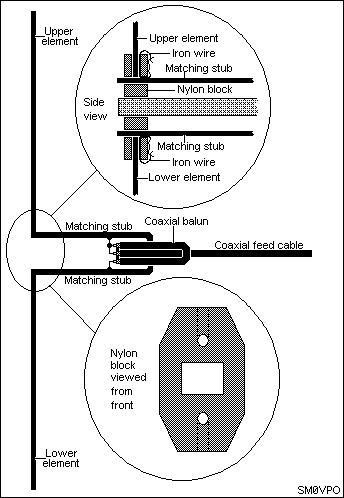
This drawing shows the basic structure. There is nothing new in technology here. My antenna is made from 4mm aluminum rods supported by nylon pieces I found in the kitchen (when my wife was away of course). The length of each element of the antenna and the cable are calculated in half a wave (1030 mm), but the cable is 5 cm longer. The cable is bent so that two parallel conductors are formed with a distance of 5 cm between them. The two radiating vibrators remain straight. All three formed elements (two vibrators and a train) are connected using two blocks cut from nylon.
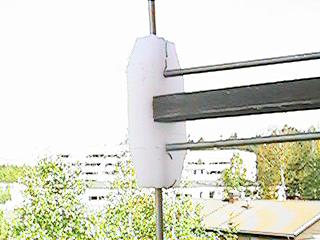
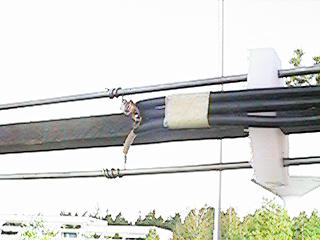
I did not show the dimensions of the cut out nylon blocks, but only their shape in the first picture. It all depends on the design and dimensions of the wood boom you have. It, of course, could be metal, but I had a piece of a wooden bar on my balcony, which I used. It is only important that it be no shorter than 1/4 wave.
Insert the central latch (boom) first, and then stick all the other elements into the dielectric blocks (they should enter with some effort). The vertical/horizontal holes at the ends of the block must have electrical contact between the vibrators and the cable. I used pieces of ferrous wire for this (it sticks to the magnet) with lead components, which has good contact between the two elements. Copper wire should not be used, as corrosion will form between it and aluminum over time.
The strength of the nylon block is more than enough to support all the elements even in strong winds.
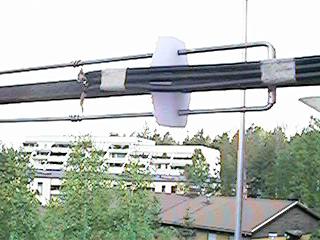
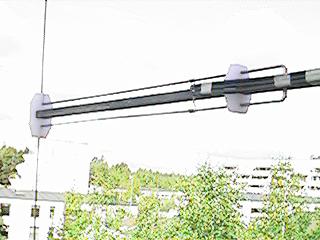
The cable is connected at a distance of 15 cm from the short-circuited end of the loop. The loop is powered by a 50-200 ohm coaxial cable through a balancing transformer. For this, an RG58 or URM76 cable is used. The length of the loop forming the transformer should be 0.33 wavelength. The half-wave radiating element for 145 MHz is 1030 mm, so the length of the coaxial transformer should be about 345 mm (folded in half).
I have recently seen several published articles using this type of antenna, but made from a copper tube. But I think that my method is much simpler and practically costs nothing both in money and in effort (of course, if your wife does not find you in the kitchen cutting off a piece of nylon).
Author: Harry Lythall (SM0VPO), Translated by N. Bolshakov.; Publication: N. Bolshakov, rf.atnn.ru
 See other articles Section VHF antennas.
See other articles Section VHF antennas.
 Read and write useful comments on this article.
Read and write useful comments on this article.
<< Back
 Latest news of science and technology, new electronics:
Latest news of science and technology, new electronics:
A New Way to Control and Manipulate Optical Signals
05.05.2024
The modern world of science and technology is developing rapidly, and every day new methods and technologies appear that open up new prospects for us in various fields. One such innovation is the development by German scientists of a new way to control optical signals, which could lead to significant progress in the field of photonics. Recent research has allowed German scientists to create a tunable waveplate inside a fused silica waveguide. This method, based on the use of a liquid crystal layer, allows one to effectively change the polarization of light passing through a waveguide. This technological breakthrough opens up new prospects for the development of compact and efficient photonic devices capable of processing large volumes of data. The electro-optical control of polarization provided by the new method could provide the basis for a new class of integrated photonic devices. This opens up great opportunities for ... >>
Primium Seneca keyboard
05.05.2024
Keyboards are an integral part of our daily computer work. However, one of the main problems that users face is noise, especially in the case of premium models. But with the new Seneca keyboard from Norbauer & Co, that may change. Seneca is not just a keyboard, it is the result of five years of development work to create the ideal device. Every aspect of this keyboard, from acoustic properties to mechanical characteristics, has been carefully considered and balanced. One of the key features of Seneca is its silent stabilizers, which solve the noise problem common to many keyboards. In addition, the keyboard supports various key widths, making it convenient for any user. Although Seneca is not yet available for purchase, it is scheduled for release in late summer. Norbauer & Co's Seneca represents new standards in keyboard design. Her ... >>
The world's tallest astronomical observatory opened
04.05.2024
Exploring space and its mysteries is a task that attracts the attention of astronomers from all over the world. In the fresh air of the high mountains, far from city light pollution, the stars and planets reveal their secrets with greater clarity. A new page is opening in the history of astronomy with the opening of the world's highest astronomical observatory - the Atacama Observatory of the University of Tokyo. The Atacama Observatory, located at an altitude of 5640 meters above sea level, opens up new opportunities for astronomers in the study of space. This site has become the highest location for a ground-based telescope, providing researchers with a unique tool for studying infrared waves in the Universe. Although the high altitude location provides clearer skies and less interference from the atmosphere, building an observatory on a high mountain poses enormous difficulties and challenges. However, despite the difficulties, the new observatory opens up broad research prospects for astronomers. ... >>
 Random news from the Archive Random news from the Archive Nanohousing for sun-loving bacteria
10.03.2022
Researchers at the University of Cambridge in the UK have 3D printed a grid of high-rise "nano-housing" in which sun-loving bacteria can grow rapidly. With these "houses," scientists have been able to extract more of the energy generated from photosynthesis from bacteria, which can be used to power small electronics - more than with traditional renewable bioenergy production methods.
Cyanobacteria are large bacteria capable of photosynthesis. For several years, researchers have been trying to "reconfigure" the mechanisms of photosynthesis in cyanobacteria in order to extract energy from them. To grow, cyanobacteria need a lot of sunlight - for this they are well suited, for example, the surface of a lake in summer. And in order to extract the energy they produce from photosynthesis, bacteria must be attached to electrodes.
A team from Cambridge has 3D printed special electrodes from metal oxide nanoparticles - highly branched, densely packed columnar structures, similar to a tiny city. Scientists have developed a printing method that allows you to control the different lengths of the bars.
The new method increased the amount of extracted energy by an order of magnitude compared to other methods of producing bioenergy from photosynthesis.
"Cyanobacteria are versatile chemical factories. Our approach allows us to use their energy conversion pathways at an early stage, which helps us understand how they perform energy conversion so that we can use their natural pathways for renewable fuels or chemical production," the authors note. work.
|
 Other interesting news:
Other interesting news:
▪ Bacterial battery for Mars
▪ TE Connectivity IHVA150 and IHVA200 DC Contactors
▪ Internet from Lufthansa
▪ Forests of the future
▪ 20TB WD Ultrastar DC HC650 SMR hard drive
 News feed of science and technology, new electronics
News feed of science and technology, new electronics
 Interesting materials of the Free Technical Library:
Interesting materials of the Free Technical Library:
▪ section of the site Personal transport: land, water, air. Article selection
▪ article With nature alone he breathed life. Popular expression
▪ article Can cats really see in the dark? Detailed answer
▪ article Planer from the corner. home workshop
▪ article Copy ink. Simple recipes and tips
▪ article Digor proverbs and sayings. Large selection
 Leave your comment on this article:
Leave your comment on this article:
 All languages of this page
All languages of this page
Home page | Library | Articles | Website map | Site Reviews

www.diagram.com.ua
2000-2024







 Arabic
Arabic Bengali
Bengali Chinese
Chinese English
English French
French German
German Hebrew
Hebrew Hindi
Hindi Italian
Italian Japanese
Japanese Korean
Korean Malay
Malay Polish
Polish Portuguese
Portuguese Spanish
Spanish Turkish
Turkish Ukrainian
Ukrainian Vietnamese
Vietnamese





 Leave your comment on this article:
Leave your comment on this article: